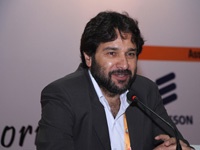BLOG: Ghazipur, a reminder of the state in which we are

By Tikender Panwar
If this picture (below) of Ghazipur seems like an isolated gory tale then hey, caution it is not! This is a reality with many such cities in India who are screaming at various levels to meet their solid waste management demands. Just a cursory look at the CPCB data reveals that over 150000 metric tonnes of municipal solid waste is generated in the country every day. However, just 12 % of it is treated. The rest is either dumped on some of such sites, or thrown in the open in different corners of the city and peri-urban areas.
In Delhi, the Municipal Council officials call it a ‘mound of helplessness’ which is not just atrocious but remains a major health hazard for the city and the neighbourhood. Quite often such mounds are seen burning which emanates toxic gases in the environment. The National and State Governments had provided an impetus to improve the solid waste management in urban areas under various programs and schemes. The Jawaharlal Nehru National Urban Renewal Mission (JnNURM) funded 49 Sewage waste Management (SWM) projects in various cities between 2006 and 2009 (MoUD, 2014). However, many such proved to be non-starters or were abandoned after functioning for a while. Some such examples are in Nagpur and Shimla cities.

This file photo was published in the Hindu Business Line (Photo credit: Ramesh Sharma)
The waste to be considered as a resource needs to be revisited and ample attention is required especially for the state for its management. The journey of waste from collection, segregation to transport and treatment is being done primarily by the local bodies. But their capacities and limitations is not a hidden fact in India.
In a recent international conference held in Delhi, on the issues and challenges of peri-urban areas, jointly by Gorakhpur environment action group (GEAG) and ICLEI South Asia, this issue was discussed widely. It was highlighted that these (peri-urban) areas cannot be a dumping ground for the cities.
On this front, intervention is required at a different scale, and has to be approached from a different angle from enhancing the capacities to bringing in the right technology for waste treatment. Otherwise, the technology itself becomes a disaster if chosen wrongly. And this is for the simple reason that the tropical and temperate regions have altogether different challenges, and hence it is also an issue of space and not just time. Similarly, the capacities too vary from regions to cities which is why it is an important consideration.
ICLEI South Asia is instrumental into building an integrated approach to this issue and especially in Indian cities namely Coimbatore in the South, Siliguri in the North East and Udaipur in the Western part of India has been kept to showcase how micro level interventions can also bring in some tangible results.
Initially, in all these cities a base analysis of waste characterisation and quantification is intended to be done. To further execute such a theoretical approach below, two wards in each city have been selected for showcasing the above theory, that is, segregation, collection and processing of waste. Institutional linkages for recycling is also being developed which will keep the process going even when the project is over. For the city of Varanasi a holistic solid waste management plan will be drawn which will guide the city for its priorities on the subject.
Such actions cannot for sure replace the macro level intervention requirement but emerge as ‘light houses’ for the bigger ‘scale’ intervention.
If this can happen in another part of the world why can’t it happen here?
Tikender Panwar is the former Deputy Mayor of Shimla.



